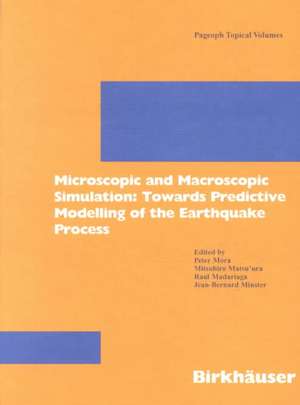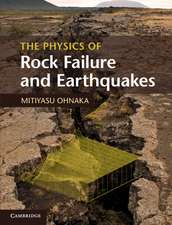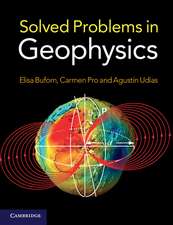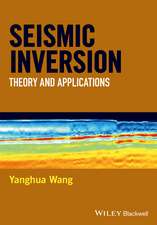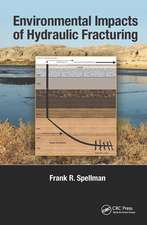Microscopic and Macroscopic Simulation: Towards Predictive Modelling of the Earthquake Process: Pageoph Topical Volumes
Editat de Peter Mora, Mitsuhiro Matsu'ura, Raul Madariaga, Jean-Bernard Minsteren Limba Engleză Paperback – 2001
Din seria Pageoph Topical Volumes
-
 Preț: 300.85 lei
Preț: 300.85 lei -
 Preț: 386.19 lei
Preț: 386.19 lei -
 Preț: 303.07 lei
Preț: 303.07 lei -
 Preț: 306.14 lei
Preț: 306.14 lei - 15%
 Preț: 720.73 lei
Preț: 720.73 lei -
 Preț: 397.38 lei
Preț: 397.38 lei -
 Preț: 314.52 lei
Preț: 314.52 lei - 15%
 Preț: 641.71 lei
Preț: 641.71 lei -
 Preț: 221.70 lei
Preț: 221.70 lei - 15%
 Preț: 726.94 lei
Preț: 726.94 lei -
 Preț: 308.55 lei
Preț: 308.55 lei -
 Preț: 320.20 lei
Preț: 320.20 lei -
 Preț: 384.70 lei
Preț: 384.70 lei -
 Preț: 301.10 lei
Preț: 301.10 lei -
 Preț: 298.66 lei
Preț: 298.66 lei -
 Preț: 299.34 lei
Preț: 299.34 lei -
 Preț: 324.18 lei
Preț: 324.18 lei -
 Preț: 392.75 lei
Preț: 392.75 lei -
 Preț: 312.97 lei
Preț: 312.97 lei -
 Preț: 307.88 lei
Preț: 307.88 lei -
 Preț: 387.96 lei
Preț: 387.96 lei -
 Preț: 405.06 lei
Preț: 405.06 lei -
 Preț: 386.00 lei
Preț: 386.00 lei -
 Preț: 396.40 lei
Preț: 396.40 lei -
 Preț: 404.29 lei
Preț: 404.29 lei -
 Preț: 391.99 lei
Preț: 391.99 lei -
 Preț: 351.49 lei
Preț: 351.49 lei - 18%
 Preț: 1106.46 lei
Preț: 1106.46 lei -
 Preț: 393.52 lei
Preț: 393.52 lei - 20%
 Preț: 568.74 lei
Preț: 568.74 lei -
 Preț: 388.72 lei
Preț: 388.72 lei -
 Preț: 380.07 lei
Preț: 380.07 lei - 15%
 Preț: 660.83 lei
Preț: 660.83 lei -
 Preț: 396.40 lei
Preț: 396.40 lei -
 Preț: 397.38 lei
Preț: 397.38 lei -
 Preț: 409.30 lei
Preț: 409.30 lei -
 Preț: 399.29 lei
Preț: 399.29 lei -
 Preț: 495.62 lei
Preț: 495.62 lei -
 Preț: 385.25 lei
Preț: 385.25 lei -
 Preț: 394.29 lei
Preț: 394.29 lei - 15%
 Preț: 647.27 lei
Preț: 647.27 lei -
 Preț: 400.47 lei
Preț: 400.47 lei -
 Preț: 395.25 lei
Preț: 395.25 lei - 15%
 Preț: 657.08 lei
Preț: 657.08 lei -
 Preț: 400.26 lei
Preț: 400.26 lei -
 Preț: 352.80 lei
Preț: 352.80 lei -
 Preț: 384.48 lei
Preț: 384.48 lei -
 Preț: 401.42 lei
Preț: 401.42 lei
Preț: 328.35 lei
Nou
Puncte Express: 493
Preț estimativ în valută:
62.84€ • 65.36$ • 51.88£
62.84€ • 65.36$ • 51.88£
Carte disponibilă
Livrare economică 24 martie-07 aprilie
Preluare comenzi: 021 569.72.76
Specificații
ISBN-13: 9783764365035
ISBN-10: 376436503X
Pagini: 588
Ilustrații: VII, 567 p. 435 illus.
Dimensiuni: 170 x 244 x 31 mm
Greutate: 0.93 kg
Ediția:2001
Editura: Birkhäuser Basel
Colecția Birkhäuser
Seria Pageoph Topical Volumes
Locul publicării:Basel, Switzerland
ISBN-10: 376436503X
Pagini: 588
Ilustrații: VII, 567 p. 435 illus.
Dimensiuni: 170 x 244 x 31 mm
Greutate: 0.93 kg
Ediția:2001
Editura: Birkhäuser Basel
Colecția Birkhäuser
Seria Pageoph Topical Volumes
Locul publicării:Basel, Switzerland
Public țintă
Popular/generalCuprins
Microscopic Simulation.- Numerical Simulation of Localisation Phenomena in a Fault Zone.- Shear Heating in Granular Layers.- Extension of the Lattice Solid Model to Incorporate Temperature Related Effects.- Hybrid Modelling of Coupled Pore Fluid-solid Deformation Problems.- Numerical Simulation of Rock Failure and Earthquake Process on Mesoscopic Scale.- Damage Localization as a Possible Precursor of Earthquake Rupture.- Evolution-induced Catastrophe and its Predictability.- Macroscopic Simulation: Short Time Scale Phenomena (Rupture and Strong Motion).- Dynamic Propagation and Interaction of a Rupture Front on a Planar Fault.- Criticality of Rupture Dynamics in 3-D.- Spontaneous Rupture Propagation on a Non-planar Fault in 3-D Elastic Medium.- Constraints on Stress and Friction from Dynamic Rupture Models of the 1994 Northridge, California, Earthquake.- Parallel 3-D Simulation of Ground Motion for the 1995 Kobe Earthquake: The Component Decomposition Approach.- Computer Simulation of Strong Ground Motion near a Fault Using Dynamic Fault Rupture Modeling: Spatial Distribution of the Peak Ground Velocity Vectors.- Numerical Simulation of Dynamic Process of the Tangshan Earthquake by a New Method—LDDA.- Nonlinear Structural Subsystem of GeoFEM for Fault Zone Analysis.- Macroscopic Simulation: Long Time Scale Phenomena (Earthquake Cycle).- 3-D Physical Modelling of Stress Accumulation Processes at Transcurrent Plate Boundaries.- The Edges of Large Earthquakes and the Epicenters of Future Earthquakes: Stress-induced Correlations in Elastodynamic Fault Models.- Precursory Seismic Activation and Critical-point Phenomena.- Evolution of Stress Deficit and Changing Rates of Seismicity in Cellular Automaton Models of Earthquake Faults.- Accelerating Seismic Energy Release andEvolution of Event Time and Size Statistics: Results from Two Heterogeneous Cellular Automaton Models.- The Plausibility of Long-wavelength Stress Correlation or Stress Magnitude as a Mechanism for Precursory Seismicity: Results from Two Simple Elastic Models.- Scaling, Data Assimilation and Forecasting.- Scale-dependence in Earthquake Processes and Seismogenic Structures.- A Physical Scaling Relation Between the Size of an Earthquake and its Nucleation Zone Size.- Regional Difference in Scaling Laws for Large Earthquakes and its Tectonic Implication.- Continuous GPS Array and Present-day Crustal Deformation of Japan.- Implications of a Statistical Physics Approach for Earthquake Hazard Assessment and Forecasting.- Application of Linked Stress Release Model to Historical Earthquake Data: Comparison between Two Kinds of Tectonic Seismicity.- Development of a New Approach to Earthquake Prediction: Load/Unload Response Ratio (LURR) Theory.
